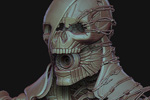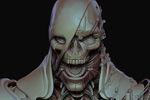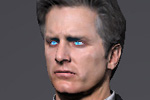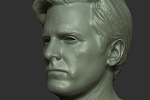How did the design for the Reaper Baby come about? Just how much can you say without giving away secrets that are waiting for 3 to be revealed?
Derek Watts – Art Director:
The Reaper Baby was another creature that became my nemesis on this game. I’m not sure if it’s possible to have every creature be a nemesis, but I came close. Eventually you just want them done and you lose track of what you are trying to make. The Reaper Baby was the end product of the humans getting processed and mixed with Reaper technology to make one Super Reaper. We had no idea what that thing should look like. Casey Hudson (Project Director) had an idea of what he wanted; it was just hard for us to get his idea down on paper. We had a bunch of concepts and even after choosing the final one we still needed to make some last minute changes. It eventually looked pretty cool and the final model was awesome.
Leroy Chen – Character Artist:
The Reaper Baby is basically a proto-form human Reaper. So we referenced Sovereign from the first Mass effect to tie it into the same Reaper family. Since it's still in its semi-finished stage, we exposed a lot more of the interior components and structures to reinforce that idea. From start to finish, the design went through a few iteration changes to reach the level of creepiness we wanted for the final fight.
The Baby features a huge amount of hard surface modeling and really sharp non-organic details. How was ZBrush used for this?
Leroy Chen – Character Artist:
The usual way of doing hard surfaces in applications like 3ds Max can get you a pretty solid result, however I find this method lacked the robustness that allows quick and fast changes. Thus I chose ZBrush to do a lot of the Reaper Baby’s fine details. ZBrush allows quick reaction time for me to respond to the art director's inputs. But before the introduction of ZBrush 3.5, to make hard surfaces in ZBrush was a bit challenging. So I prepared my mesh in Max first and instead of adding extra loops in areas like sharp edges to keep the form under mesh smooth, I picked smoothing group as the method to separate the surfaces. Through this method I made sure the mesh had the necessary clean shapes and the proper loop distribution for detailing in ZBrush. Once in ZBrush, I used brushes like Ram, Slash 2, and Pinch to do the panel lines. In addition, masks and projection were also heavily applied in the process to achieve the desired effects. However, with brushes like Planar Cut and functions like redistribution of edges in 3.5, the workflow can now be even more efficient.




The Illusive Man bears a pretty strong physical resemblance to Martin Sheen, who voices him. Was this intentional?
Ken Finlayson – Character Artist:
From my perspective it wasn’t a factor at all. The asset was done, and it was probably November or December when I found out Martin Sheen was going to be the voice. A few different actors were thrown around when the Illusive Man was just a drawing in the conceptual stages. Eventually a model (not Martin Sheen) was chosen and then scanned as a base for the head. Generally the hero human characters start from a scan, but we do a lot of alterations to that data to find the character and get the look we want. You would be hard pressed to find a guy that looked like Zaeed on the street. I personally deleted and rebuilt the scan back from about the 100K poly level, putting in weight, form and accentuating details that just aren’t in the raw data.
Sometimes the scan has a cooked-in expression we need to take out. I remember Zaeed looked like he was sucking on a lemon. I assume this was from stage direction to play up the wrinkles around his mouth. Then of course there were elements of the design like a scar we needed to add in that just weren’t present at all.
The Illusive man was a pretty interesting asset to build because he is essentially a real-time cinematics asset. He had a few design features and requirements that meant he broke the mold a bit in regards to a normal human in ME. One of the first things I did was talk to Cinematics about the types of shots he would need to hold up to while not being a ridiculously expensive asset. He needed hands that would hold up to close ups. I also made a special set of teeth and tongue for him. He has 3 UV sets for just the head to get the resolution I wanted on the chest, hair and face. The Illusive man also had an open shirt which extended far below where our head meshes usually end and well below the scan data we got. I ended up having to add geometry to the scan by sewing in a specific amount of geometry at the 100K poly level. That way I could keep what I liked in the scan and I could then rebuild hierarchy on the mesh and restore all my SUBD levels. This allowed me to get back to the in-game head mesh again and have it propagate to my changes. After that it was a straightforward sculpt.
How did the idea of his cybernetic eyes come about?
Derek Watts – Art Director:
The Illusive Man was based on a concept Casey had found. This became a good starting point for us to work from. He wanted a 40-50 year old man with almost a department store catalogue model look; a good looking man that had the whole world in his hands. One of those Fortune 500 guys that just seems to have everything figured out. After we had that, he still needed a hook that people would remember. The original reference had the man wearing glasses. We realized he needed something in his eyes that would resonate with the player. We decided to add lights into his irises for interest. A simple addition like that can go a long way to increase people’s interest in the character. It leaves a lot of room for interpretation. It gets the forums talking.
Ken Finlayson – Character Artist:
We try to have a reason behind most things in the Mass Effect universe so that it feels real and authentic. There is a back story to the Illusive man’s glowing eyes, but it has not been revealed yet.







